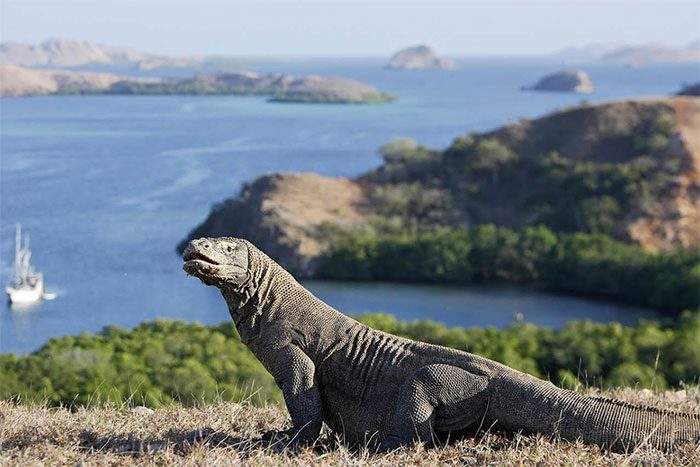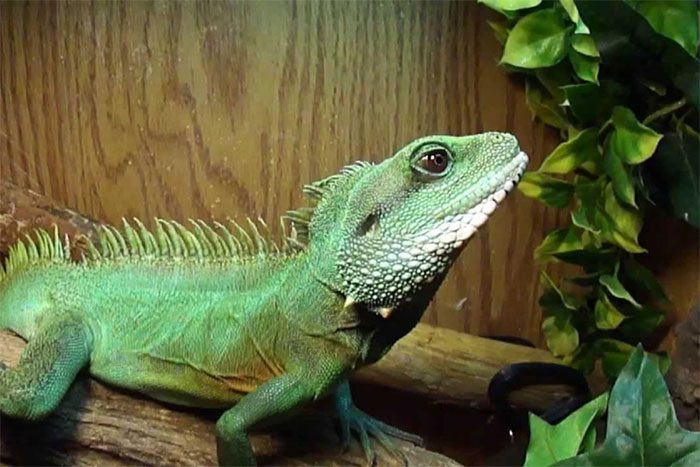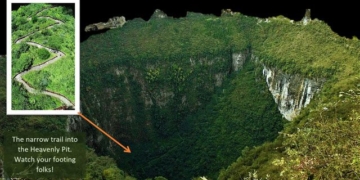The Komodo Dragon, scientifically known as Varanus komodoensis, is recognized and protected by the international community. It has been officially listed under CITES Appendix I since July 1, 1975. The Komodo Dragon was successfully proposed by Vietnam and the European Union with 75% consensus at the CITES member countries conference in 2022, and it officially became part of the CITES Appendix on February 23, 2023.
Komodo Dragon: A Treasure of Indonesia
The Komodo Dragon (scientific name: Varanus komodoensis) is an endemic and critically endangered species. This reptile is only found in Indonesia, specifically on four islands: Komodo, Rinca, Flores, and Padar, where it occupies exclusive habitats.
The Komodo Dragon is the longest-lived species among reptiles, with a maximum lifespan of up to 50 years in the wild. It is also the largest lizard species, weighing up to 165 kg and measuring up to 3 meters in length. The Komodo Dragon prefers hot, dry environments and typically inhabits dry grasslands, savannas, and lowland tropical forests. It is most active during the day and can reach speeds of up to 20 km/h, dive to depths of 4.5 meters, and climb trees proficiently.

The Komodo Dragon is a critically endangered and rare animal.
The Komodo Dragon also possesses excellent sensory abilities: it can see up to 300 meters away, has a keen sense of smell for detecting food, and uses its forked tongue to sense scents. It is an apex predator in its habitat and is one of the largest animals present in the area. Additionally, it is a scavenger, feeding on carrion and helping to clean the landscape.
The diet of adult Komodo Dragons primarily consists of carrion, but they can also attack and consume various large prey, including goats, pigs, deer, wild boars, horses, water buffalo, and younger Komodo Dragons. They ambush larger prey and bite, then follow the wounded animal until it bleeds out or succumbs to infection.
The saliva of the Komodo Dragon is rich in bacteria, which can quickly infect the prey. Their saliva contains over 50 different strains of bacteria that can lead to death from infection, even from a single bite.
This lizard species typically forages but can also run quickly and hunt stealthily, bringing down prey with powerful strikes using its claws and teeth.
Juveniles primarily eat grasshoppers, beetles, small geckos, eggs, birds, and eventually small mammals. Komodo Dragons can swallow large pieces of food by expanding their throat and flexible skull. They consume most of their prey, leaving very little waste.
Adult Komodo Dragons sit at the top of the food chain, with no natural predators. Juveniles often become prey for adults and larger mammals or birds. They avoid predation by living in trees until they grow larger.
Komodo Dragons are critically endangered in the wild and are listed under CITES Appendix I, which prohibits international trade for commercial purposes. The species is threatened due to declining prey populations, habitat loss, and increasing illegal hunting.
Green Dragon: A Captivating Species
The Green Dragon (scientific name: Physignathus cocincinus) is a lizard species widely distributed from southern China to Vietnam, Laos, Cambodia, Myanmar, and Thailand.
In Vietnam, the Green Dragon lives in the wild, found in various provinces including Hà Giang, Cao Bằng, Yên Bái, Bắc Cạn, Thái Nguyên, Lạng Sơn, Phú Thọ, Hòa Bình, Bắc Giang, Quảng Ninh, Vĩnh Phúc (Tam Đảo); the former Hà Tây (Ba Vì), Ninh Bình (Cúc Phương), Thanh Hóa, Nghệ An, Hà Tĩnh, Quảng Bình, Quảng Trị, and Thừa Thiên Huế.
The Green Dragon inhabits rocky streams under the canopy of evergreen forests, mixed with deciduous trees, and bamboo forests at elevations ranging from 43 to 820 meters above sea level. They are amphibious and arboreal, found along freshwater streams. Green Dragons are diurnal, exhibiting low mobility, moving an average of 4.7 to 6.1 meters per day. At night, they typically rest on branches over water.
During the active season, Green Dragons are most active from 10 AM to 1 PM in Vietnam. When threatened, they exhibit a fleeing behavior by jumping into the water or running swiftly on two legs into the bushes.

The Green Dragon has quite an attractive appearance.
This species is an excellent swimmer. Green Dragons are omnivorous, primarily consuming invertebrates, but they also eat fish, small mammals, birds, reptiles, and some plant parts. In breeding environments, they eat mice, beef heart, fish, cat and dog food, and various fruits.
Green Dragons have body colors ranging from green to gray-brown, used for camouflage in their natural habitat. The scales on their lower jaw and cheek regions may be white, green, or red to orange. Males sometimes exhibit yellow, orange, to white colors around their armpits, jaws, and chest.
With a flattened body and tail, Green Dragons possess strong limbs suitable for climbing. The snout shape can vary depending on the distribution area. Mature individuals have a continuous crest from the neck to the back, distinct from the crest on the front part of the tail. The crest develops with age and is more pronounced in males. The tail features dark vertical stripes along its length.
Juveniles have bright horizontal stripes across their bodies along with lateral lines that fade with age. A dark vertical stripe runs from behind the eyes to the ear openings.
In mature individuals, there is a clear sexual dimorphism. Males have larger jowls and more pronounced cheeks. The external appearance of females is noticeably smaller than that of males.
The body length of the Green Dragon can reach up to 0.9 meters. With a flattened body and tail, Green Dragons possess strong limbs suitable for climbing. They are particularly territorial and can be aggressive in breeding environments. The maximum lifespan of a Green Dragon is only 15 years.
The Green Dragon has been listed under CITES Appendix II, which restricts international trade for commercial purposes. The population of Green Dragons in the wild in Vietnam is dwindling and requires effective conservation and protection.




















































